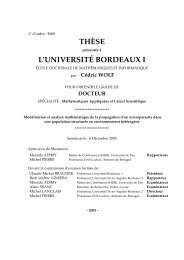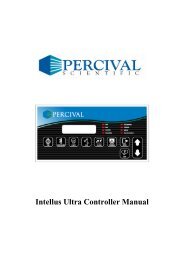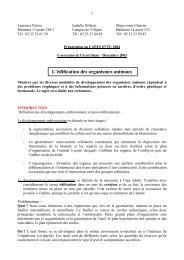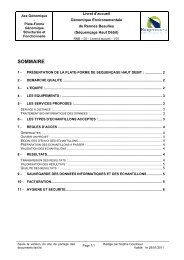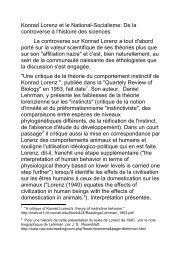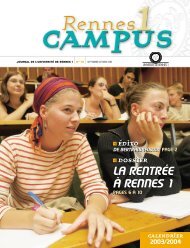1 CHIRONOMUS NEWSLETTER ON CHIRONOMIDAE RESEARCH ...
1 CHIRONOMUS NEWSLETTER ON CHIRONOMIDAE RESEARCH ...
1 CHIRONOMUS NEWSLETTER ON CHIRONOMIDAE RESEARCH ...
You also want an ePaper? Increase the reach of your titles
YUMPU automatically turns print PDFs into web optimized ePapers that Google loves.
laboratory insects, and the first and second<br />
instars are very good food sources for third and<br />
fourth instar tanypods.<br />
Importance of Isolated material:<br />
Quite often there are more than one species of<br />
the same genus living in the same habitat, so<br />
rearings are from isolated larvae; this method<br />
will ensure correct associations of the adults<br />
with the larval and pupal exuviae. I’ve already<br />
found seven species of the same genus in the<br />
littoral zone of one lake (Labrundinia).<br />
Another way to ensure associations without<br />
isolating, is to get larvae from egg masses or<br />
pregnant females, for those, the methods<br />
described by BRANCH (1923), CREDLAND<br />
(1973), EDWARD (1963) BIEVER (1965)and<br />
DOWNE & CASPARY (1973) work very well.<br />
Notes on the reared material:<br />
Orthocladiinae<br />
Antillocladius, Bryophaenocladius, Gymnometriocnemus<br />
and Orthocladiinae new Genus<br />
(being described by Morraye & Sæther). No<br />
additional food is required for these larvae.<br />
They feed on the sediment and substratum. All<br />
species I’ve already reared fed on sediment<br />
and decomposed lichens and bryophytes. Very<br />
often there are more than one species of<br />
Bryophaenocladius in the same sample, so be<br />
sure there is only one larva in the vial.<br />
Corynoneura, Onconeura (Andersen &<br />
Sæther, in press) and Thienemanniella. This<br />
are very easy to rear as the larvae feed on<br />
flavoured fish food. One must pay attention to<br />
how much is required, and be sure it won’t<br />
decompose and waste the water oxygen<br />
(specially by Thienemanniella). The<br />
Corynoneura-group and some other genera<br />
build transparent cocoons for the pupa. Taking<br />
the pupa out of these cocoons can be very<br />
difficult without damaging the pupa, so the<br />
entire dish where the larva became pupa must<br />
go into the bigger container. Some animals of<br />
this group emerge in the vials suggested by<br />
EPLER (1995), but many Thienemanniella<br />
don’t.<br />
Cricotopus. The larvae become adult if fed<br />
with periphyton attached to roots and<br />
submerged leaves, which must be taken with<br />
the collection of the larvae.<br />
Ichthyocladius. These animals live on catfish<br />
and must stay there till the adults emerge. Each<br />
fish may have only one larva on it (to prevent<br />
wrong associations) and must stay in an<br />
isolated aquarium with a net covering. The fish<br />
must be fed with periphyton and one doesn’t<br />
31<br />
have to be worried about feeding the<br />
orthoclads. As soon as the pupae emerge, the<br />
adults must be killed, the pupal exuviae will<br />
remain on the water surface and the larval<br />
exuviae will remain in the cocoon attached to<br />
the fish.<br />
Tanypodinae<br />
Ablabesmyia. These larvae may be fed with<br />
dead chironomid larvae, small living larvae<br />
and pieces of Oligochaeta. I’ve already reared<br />
larvae from second instar till adults feeding<br />
them only with Oligochaeta.<br />
Coelotanypus and Clinotanypus. Most of the<br />
larvae were fed with sediment detritus and first<br />
instar of Chironomini.<br />
Conchapelopia and Pentaneura. The larvae<br />
were fed with Oligochaeta only.<br />
Fittkauimyia. These animals generally won’t<br />
finish the development without being fed with<br />
other chironomids or Oligochaeta.<br />
Labrundinia. The only way to rear these<br />
animals was with feeding them with algae and<br />
colonial benthic rotifers. I’ve got some animals<br />
from eggs to adults feeding them this way.<br />
Larsia. Many species of this genus can be fed<br />
only with parts of Oligochaeta.<br />
Monopelopia. This is a difficult genus that can<br />
feed on live animals or on detritus. All species<br />
I’ve reared from Phytotelmata fed on detritus<br />
and some drops of detritus were sufficient to<br />
get adults from second instar larvae.<br />
Acknowledgements:<br />
This study was supported by the State of São<br />
Paulo Research Foundation (FAPESP) (project<br />
00/05903-9 and project 98/05073-4) within the<br />
BIOTA/FAPESP – The Biodiversity Virtual<br />
Institute Program (www.biotasp.org.br). Some<br />
critics on this manuscript deserve mention,<br />
among them, Adriano S. Melo, Sofia<br />
Wiedenbrug and Claudio Froehlich.<br />
References:<br />
BAY, E. C. 1967. An inexpensive filter-aquarium<br />
for rearing and experimenting with aquatic<br />
invertebrates.- Turtox News 45: 146-148.<br />
BIEVER, K. D. 1965. A rearing technique for the<br />
colonization of chironomid midges.- Ann. Ent.<br />
Soc. Am. 58:135-136.<br />
BRANCH, H. E. 1923. The life history of<br />
Chironomus cristatus Fabr. With descriptions of<br />
the species.- J. N. Y. Ent. Soc. 1:15-30.<br />
CREDLAND, P. F. 1973. A new method for<br />
stablishing a permanent laboratory culture of<br />
Chironomus riparius MEIGEN (Diptera:<br />
Chironomidae).- Freshwater Biol. 3:45-51.



